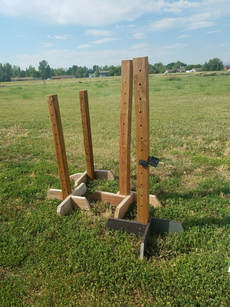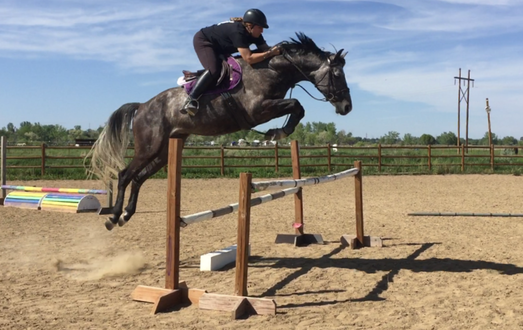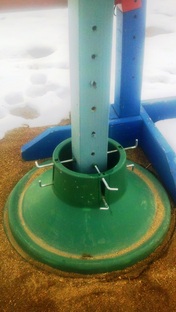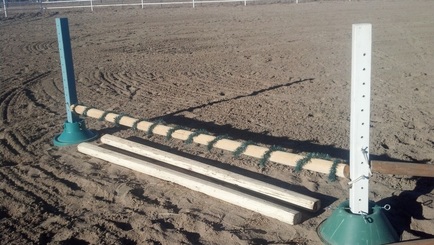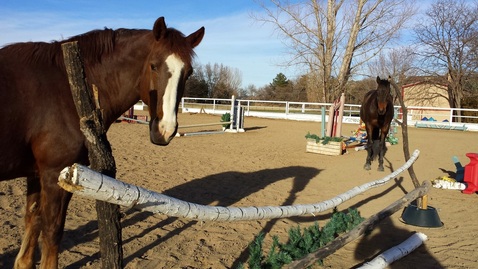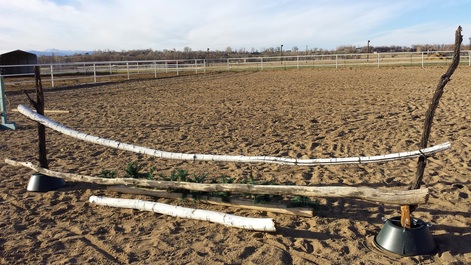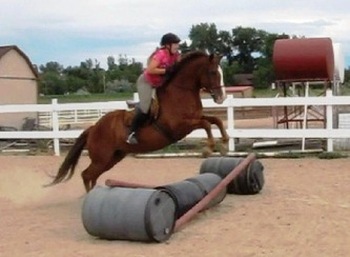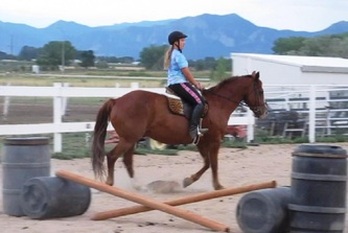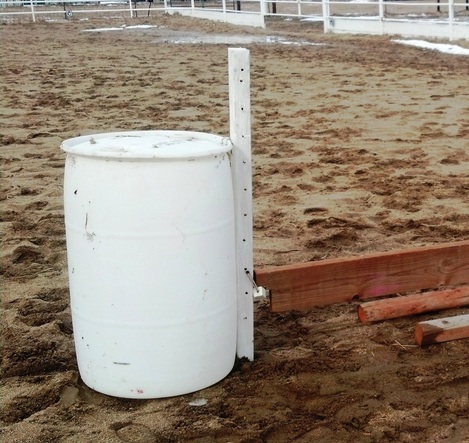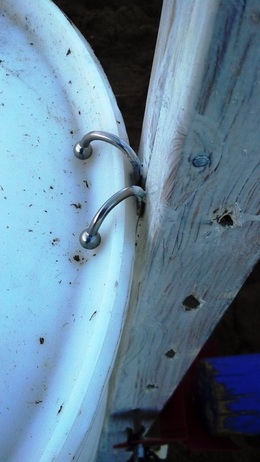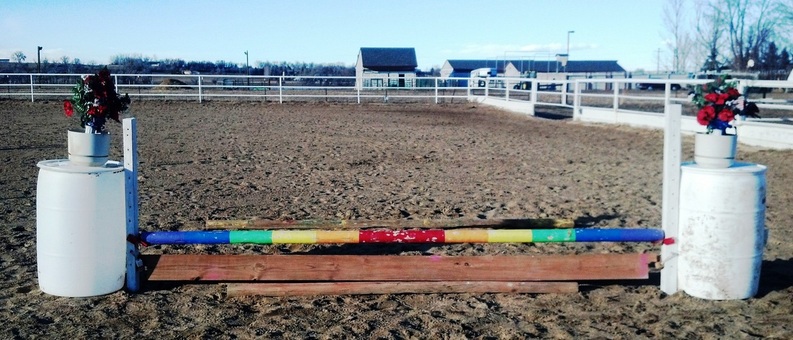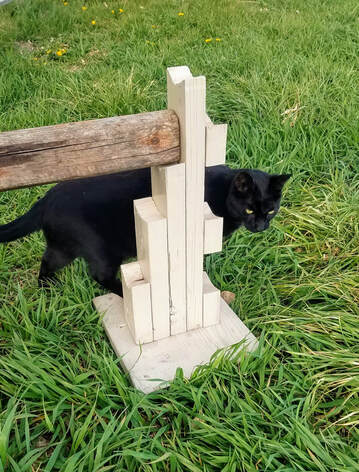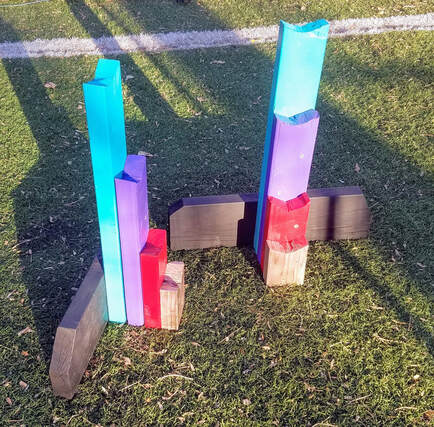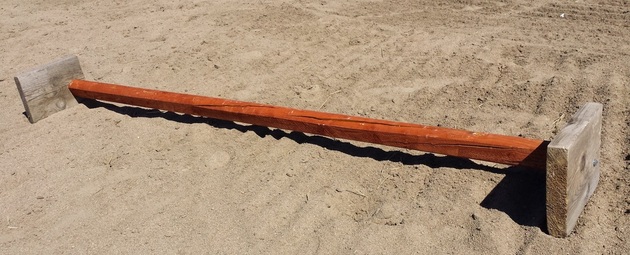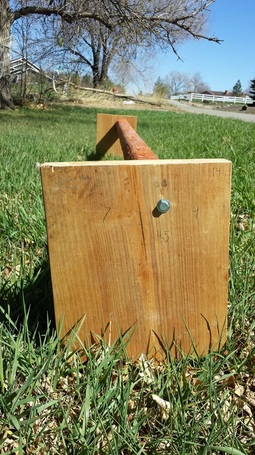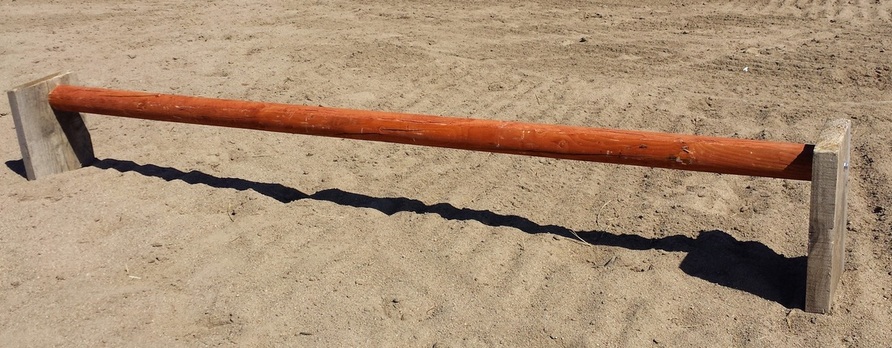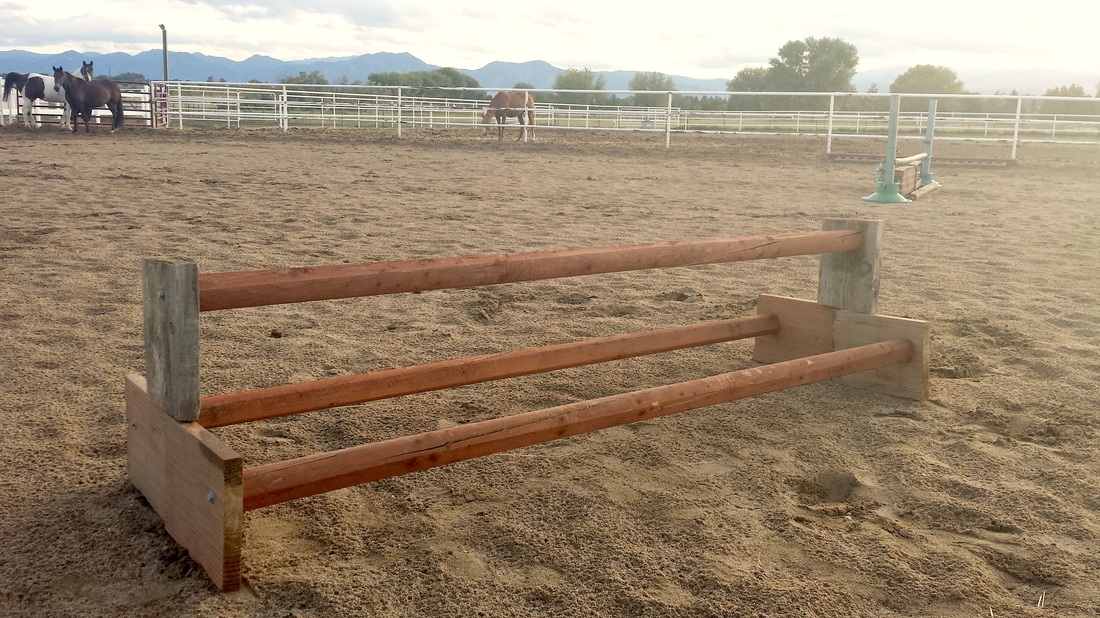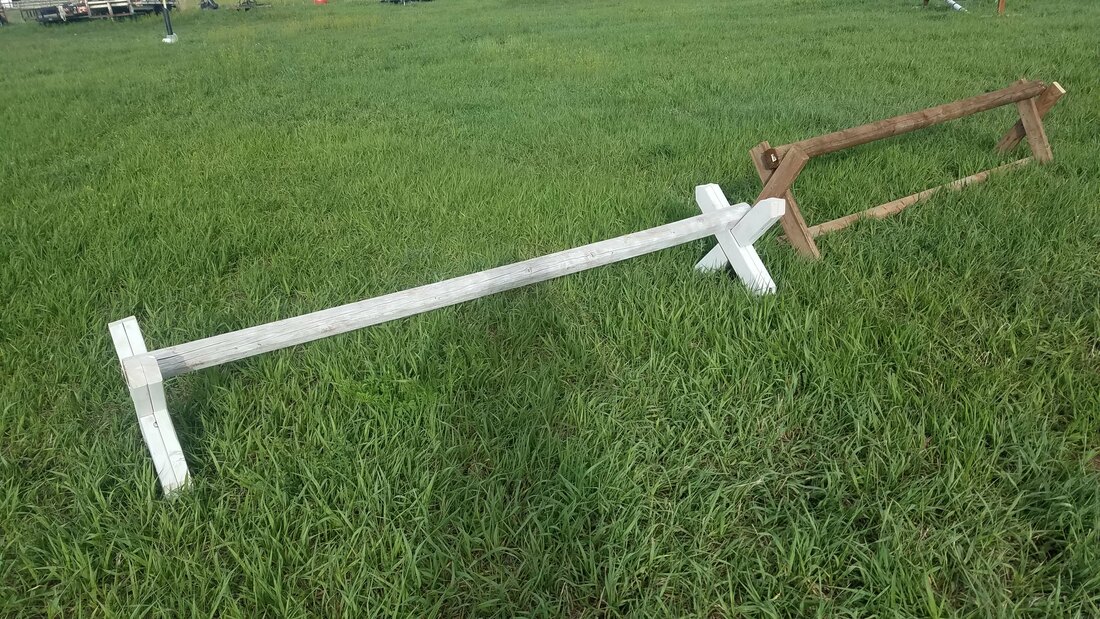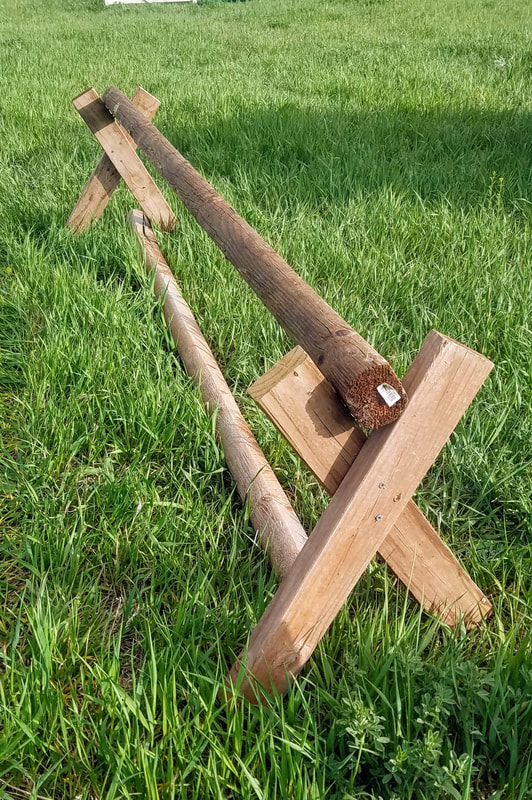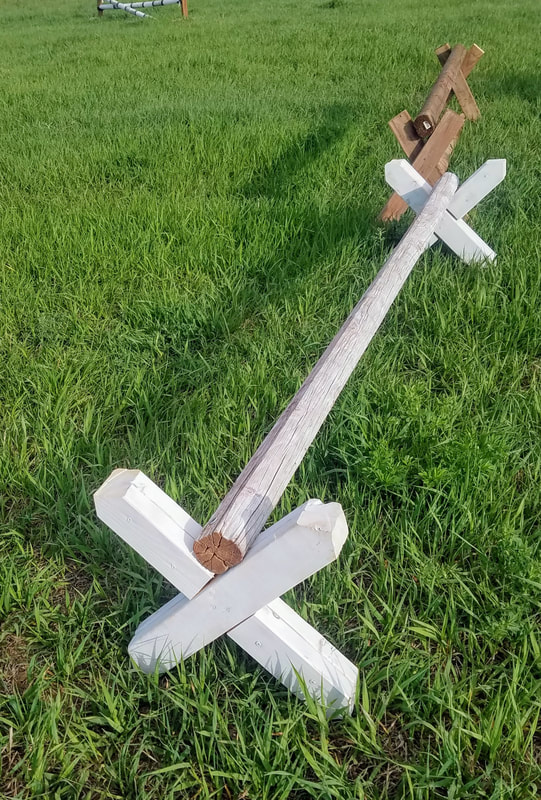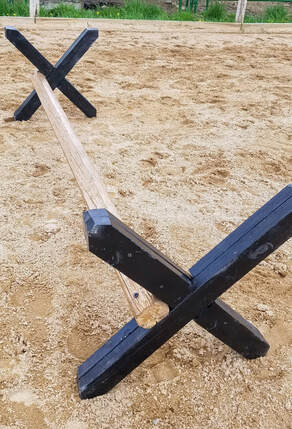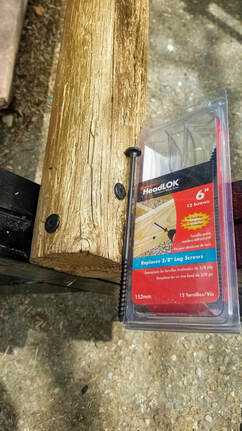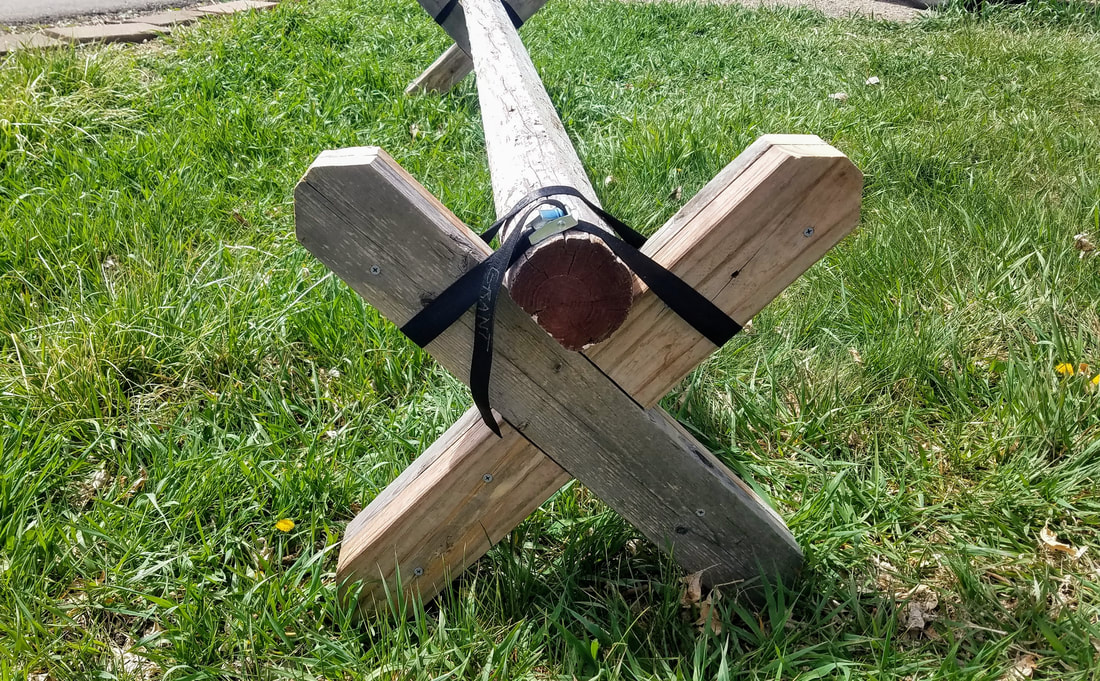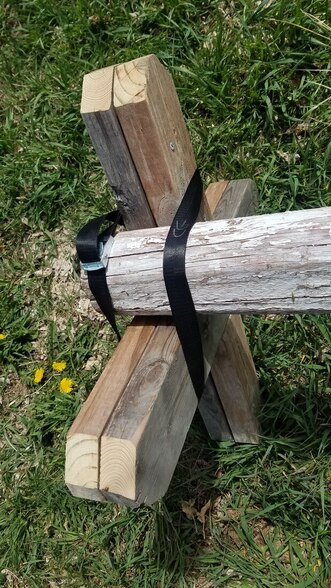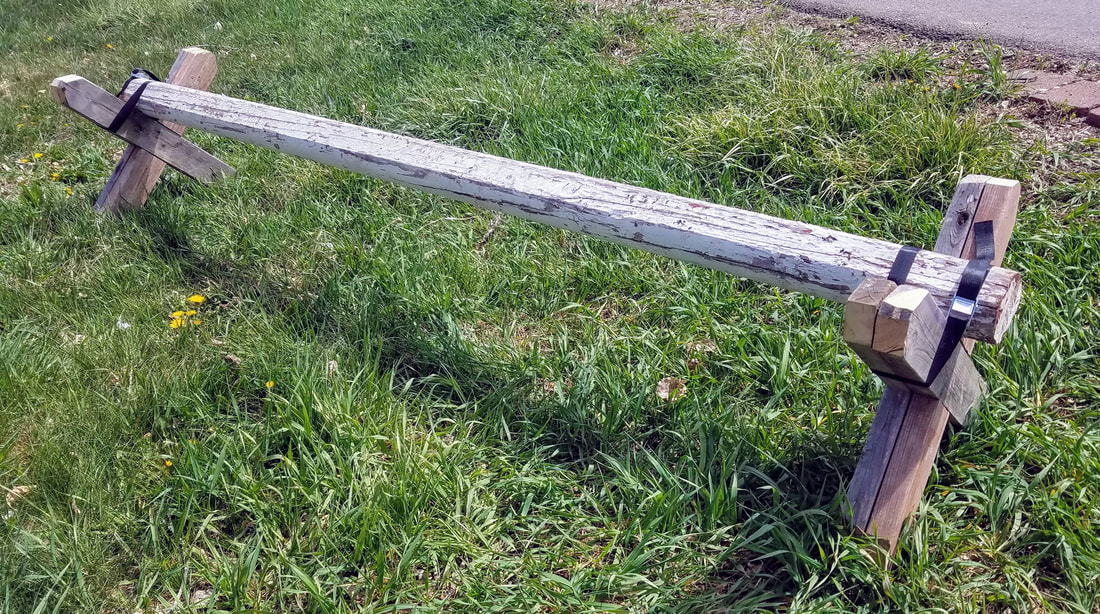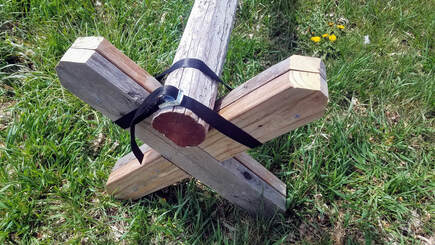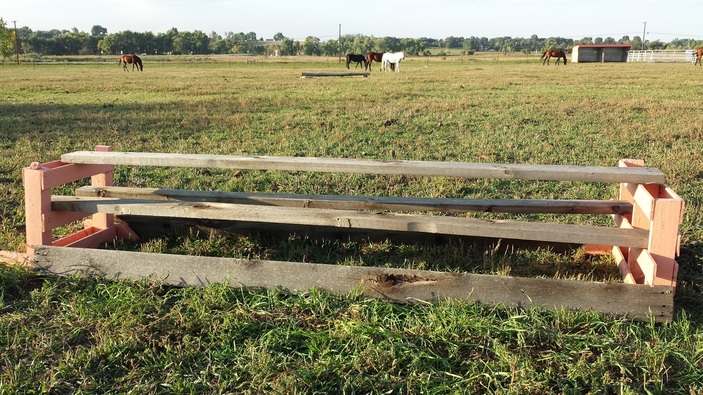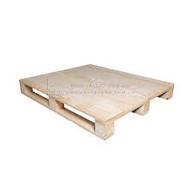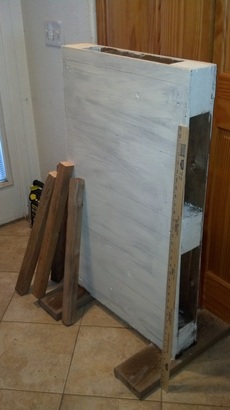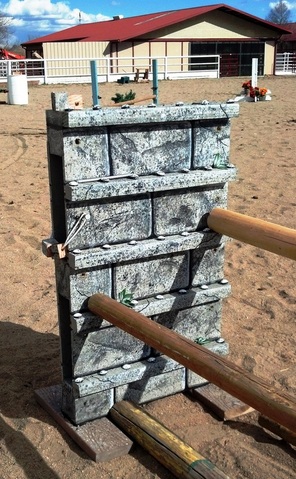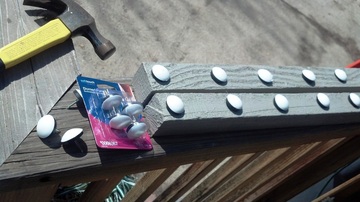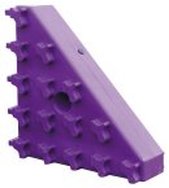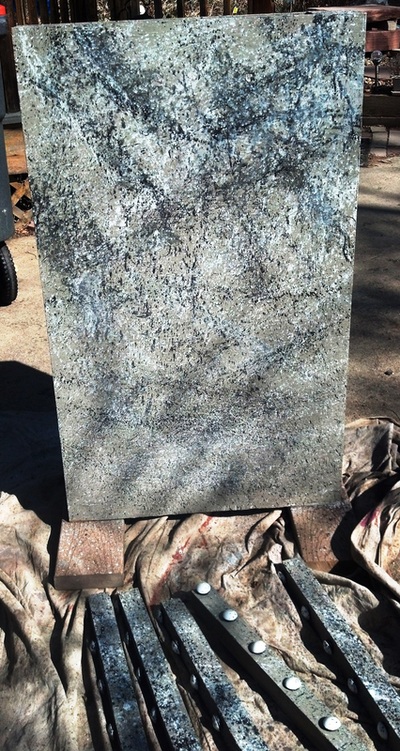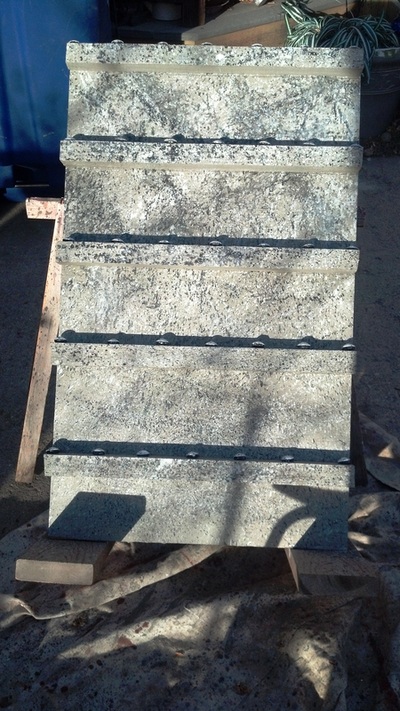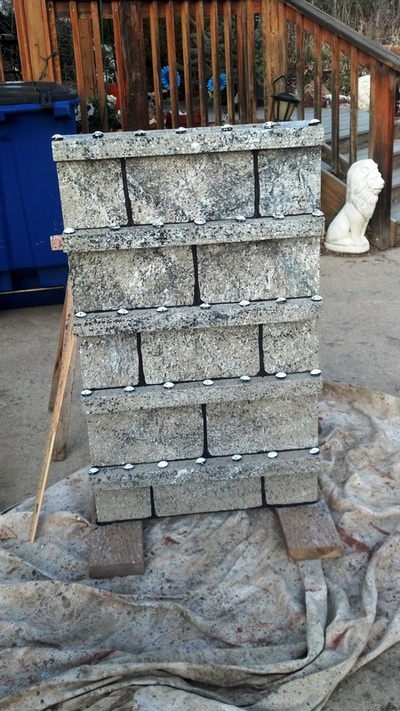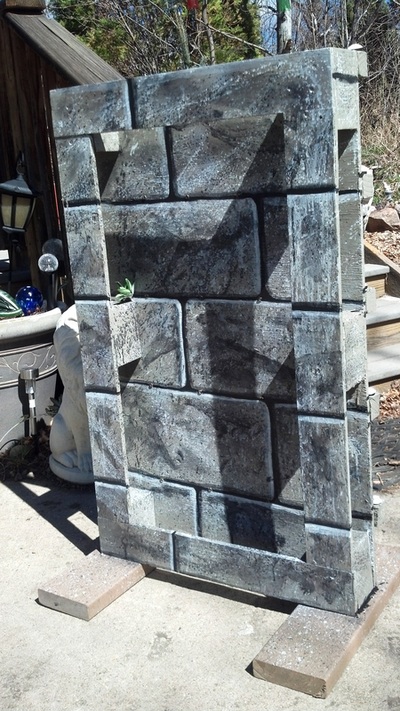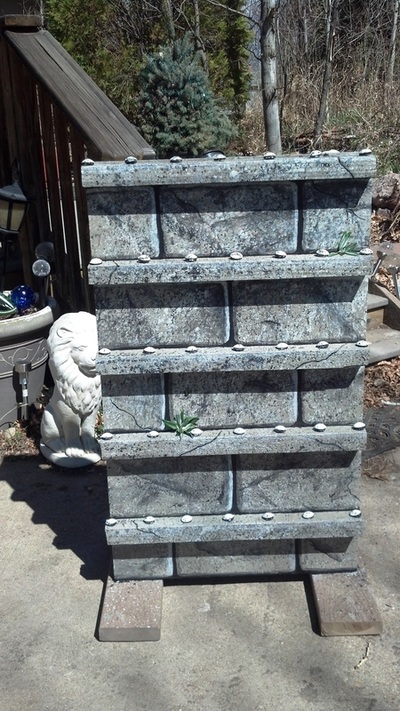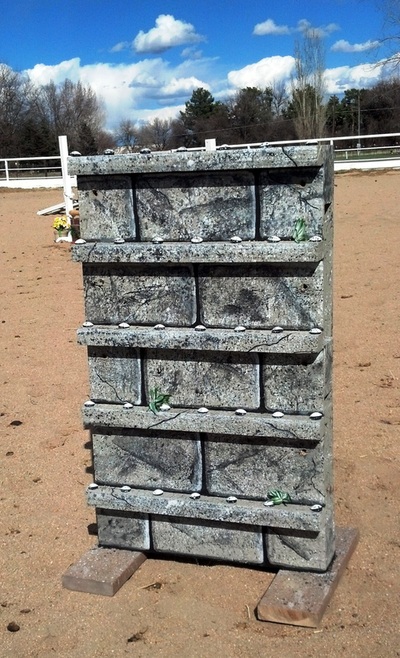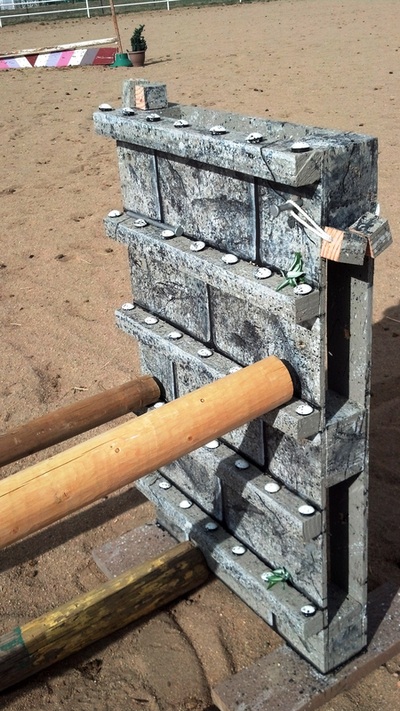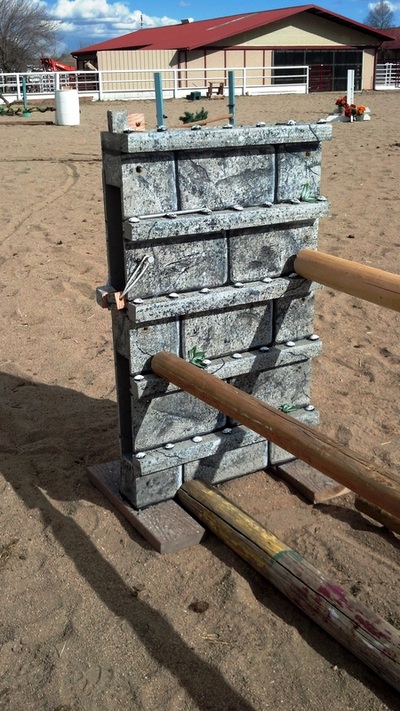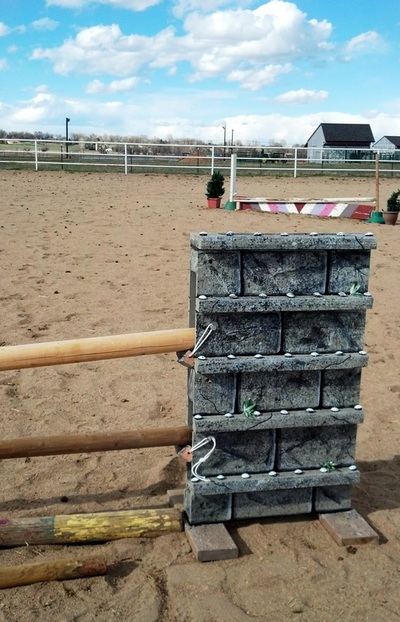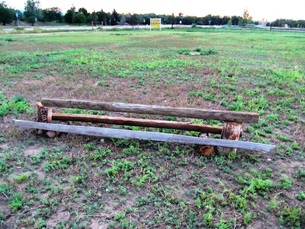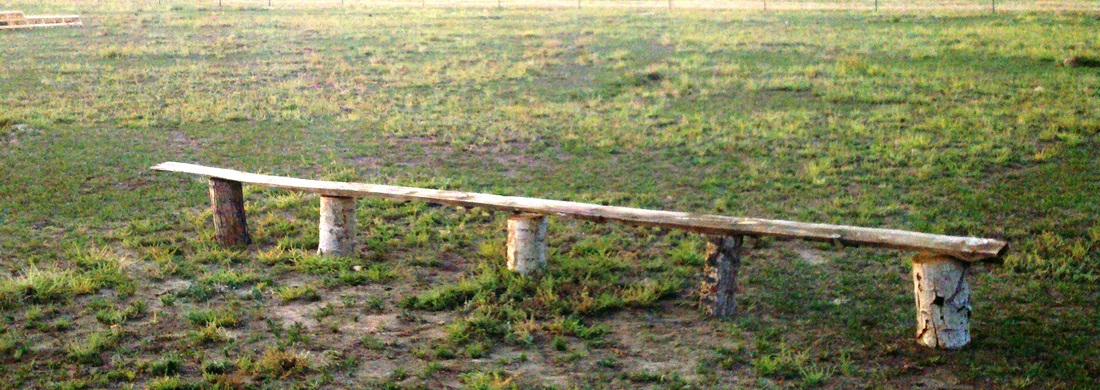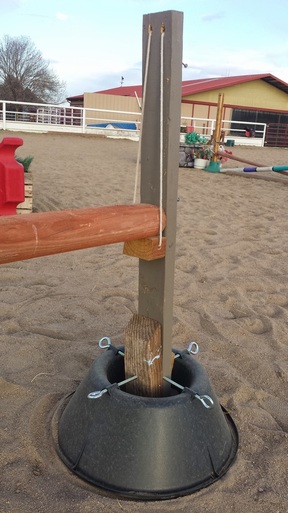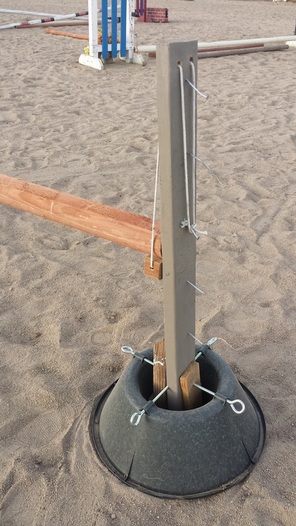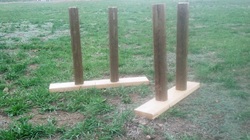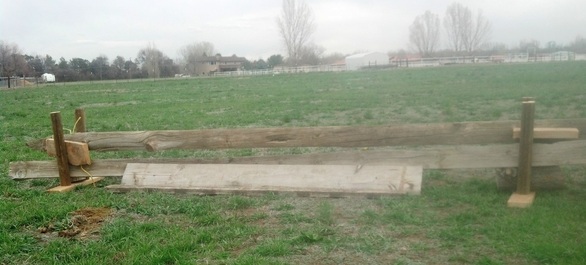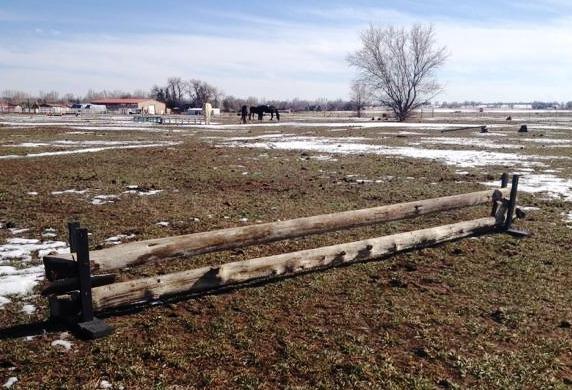Basic Classic Jump Standards
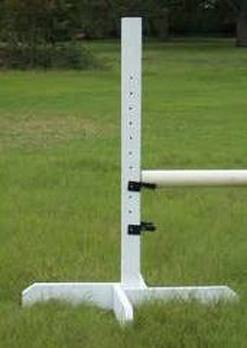
A very basic, inexpensive and versatile "pole holder".
Start with an 8' 4 x 4. Have Home Depot cut it into 2 4' sections.
Mark for holes every 3 inches, starting 9 inches from one end. Drill holes. They will be straighter if you drill small holes first, then go back with a larger bit to widen.
Cut an 8' 2 x 6 board into 4 2' sections. Lop off a corner if you like - it does look more "finished". (I might actually go with shorter feet next time so my oxers can be narrower when I have 2 together)
Use wood decking screws to attach legs. Screws hold much better than nails. A "pinwheel" pattern as shown is very common and sturdy. I'd suggest 4 screws per leg.
Try to keep the legs fairly level by lining each up with the upright. However, the nice thing is that if you use them in an arena it won't matter that much with the uneven, sandy surface.
Paint as desired.
Mark your jump heights on the standards with Sharpie marker, or even paint with bands so you can easily visually tell at one end that the pole is the same height as the other end, so will be level.
Start with an 8' 4 x 4. Have Home Depot cut it into 2 4' sections.
Mark for holes every 3 inches, starting 9 inches from one end. Drill holes. They will be straighter if you drill small holes first, then go back with a larger bit to widen.
Cut an 8' 2 x 6 board into 4 2' sections. Lop off a corner if you like - it does look more "finished". (I might actually go with shorter feet next time so my oxers can be narrower when I have 2 together)
Use wood decking screws to attach legs. Screws hold much better than nails. A "pinwheel" pattern as shown is very common and sturdy. I'd suggest 4 screws per leg.
Try to keep the legs fairly level by lining each up with the upright. However, the nice thing is that if you use them in an arena it won't matter that much with the uneven, sandy surface.
Paint as desired.
Mark your jump heights on the standards with Sharpie marker, or even paint with bands so you can easily visually tell at one end that the pole is the same height as the other end, so will be level.
Simplified Classic Jump Standard
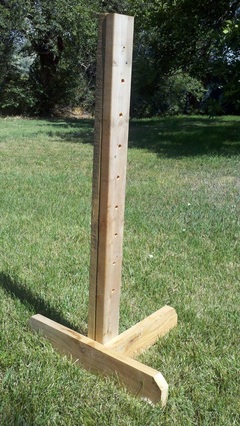
A Dilemma: I wanted another jump standard, but didn't have any 4x4's, and didn't want to spend the money, plus make a trip to the lumber store.
But I did have some scrap 2x4's and a 3 1/2 foot scrap of 2x6......
So I screwed the 4' 2x4's together to make the upright. (4 3" deck screws) Voila!
I drilled holes every 4 inches starting at 1 ft. for the jump cup pins.
Then I cut the 2x6 into 2 unequal sections for the feet (about 22" and 20") and screwed them on.
Only had to make 1 saw cut (plus the dog ears).
Plus the foot arrangement, besides being easier to make and attach, is also easier to roll poles and move filler underneath.
I'm showing it unpainted here so you can see the construction better. Once painted you can't really even tell it's not a regular standard.
But I did have some scrap 2x4's and a 3 1/2 foot scrap of 2x6......
So I screwed the 4' 2x4's together to make the upright. (4 3" deck screws) Voila!
I drilled holes every 4 inches starting at 1 ft. for the jump cup pins.
Then I cut the 2x6 into 2 unequal sections for the feet (about 22" and 20") and screwed them on.
Only had to make 1 saw cut (plus the dog ears).
Plus the foot arrangement, besides being easier to make and attach, is also easier to roll poles and move filler underneath.
I'm showing it unpainted here so you can see the construction better. Once painted you can't really even tell it's not a regular standard.
Further resources for building schooling jump standards
Here are some good instructions for building the simple upright standards:
http://www.horsechannel.com/horse-exclusives/building-jump-standards.aspx
http://lorienstable.com/articles/jumping/900-building_jumps/
http://www.wikihow.com/Build-a-Horse-Jump-1-Pair-Schooling-Standard
http://www.horsechannel.com/horse-exclusives/building-jump-standards.aspx
http://lorienstable.com/articles/jumping/900-building_jumps/
http://www.wikihow.com/Build-a-Horse-Jump-1-Pair-Schooling-Standard
Barrels as Standards
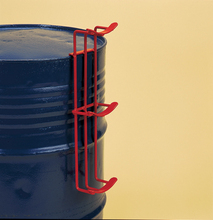
You could attach commercial jump pole holders or ...
...fairly easily
make your own by attaching a 2x4 or 4x4 with holes drilled in it, just like the regular jump standard but no feet.
You can make them taller than the barrels. Put one on each side to make 2 jumps from 3 standards.
I made them DETACHABLE using hooks, so I can use the barrels in other ways.
...fairly easily
make your own by attaching a 2x4 or 4x4 with holes drilled in it, just like the regular jump standard but no feet.
You can make them taller than the barrels. Put one on each side to make 2 jumps from 3 standards.
I made them DETACHABLE using hooks, so I can use the barrels in other ways.
Jump Blocks
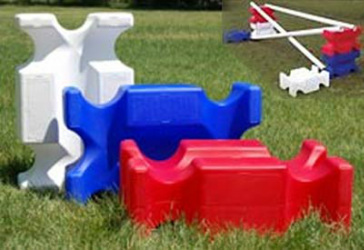
Plastic cubes with notches.
When you buy make sure the price is per PAIR. Also beware hefty shipping charges!
These can also be used as fillers under jumps.
I found that people have come up with clever ways to build home made jump blocks too!
When you buy make sure the price is per PAIR. Also beware hefty shipping charges!
These can also be used as fillers under jumps.
I found that people have come up with clever ways to build home made jump blocks too!
Home Made Jump Block
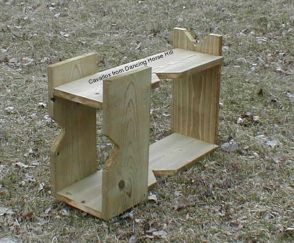
They sell home made jump blocks like these here:
http://dancinghorsehill.com/jumps.html
Three height options, and I think you can stack them too.
http://dancinghorsehill.com/jumps.html
Three height options, and I think you can stack them too.
Cavalletti
|
Stack cavalletti in various configurations to make jumps. I like these a lot because carrying them is so easy - no dragging around standards or messing with jump cups.
|
The rectangle is 11 inches by 14 inches.
The hole was drilled using offets clockwise from top: 2.5 inches, 4 inches, 11.5 inches, 7 inches. |
I found this page on www.budgetequestrian.com to be really great for cavaletti building steps.
I got tired of splitting wood and wobbling attachments with screws (plust expensive long screws). So I am attaching whatever poles I want (in this case a cheap landscaping pole) to my sturdy Xs with cam buckle cargo straps (3 feet long x 1 inch wide).
BONUS - SO MUCH EASIER TO TRANSPORT the 3 separate pieces from home to barn in my car.
BONUS II - I can change out whatever length or size of pole I want!
BONUS - SO MUCH EASIER TO TRANSPORT the 3 separate pieces from home to barn in my car.
BONUS II - I can change out whatever length or size of pole I want!
Pallets

When vertical, some have enough spacing between the slats to lay a pole.
Add feet (a short 2x4 attached to the bottom of one or both sides) and use as "standards".
Add feet (a short 2x4 attached to the bottom of one or both sides) and use as "standards".
Pallet Jump Block
|
Recycle a (free) pallet into a jump block standard.
This is a pallet that is solid on 1 side. I primer-painted it. The feet are scrap plastic decking boards (no rot!) The 2x2's will be the pole rests. (It's inside because it was too cold and snowy outside to do anything!) |
Making the Pallet Jump Block
Click for larger image and instructions.
Firewood Logs
Experiment - Creative Standards
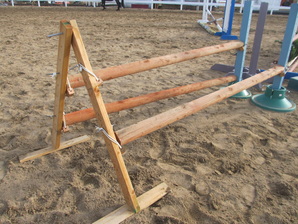
This is a "prototype" but seems to work. Just 2 x 4's with a crosspiece "foot" to make it self-supporting. The top is "hinged" with a carriage bolt or jump cup pin (galvanized spike).
I just drilled holes in each 2 x 4 and used the home made jump cups for poles.
Very portable and storeable, and cheap and easy to make.
Makes nice oxers of varying heights.
I just drilled holes in each 2 x 4 and used the home made jump cups for poles.
Very portable and storeable, and cheap and easy to make.
Makes nice oxers of varying heights.
This is a minimalist standard! A single 2 x 4 scrap and a loop of rope. Just 2 holes the rope can slide through, and nail pegs on the back to adjust the height of the "jump cup". I used short wood scraps to build out the base of the 2 x 4 to fit in this cheap-o Christmas tree stand. (75 cents at Walmart after Xmas sale :-)
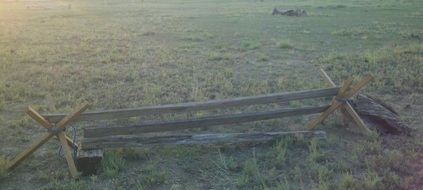
Tripods - scrap 2x2's tied with rope. Spread out the "legs" and the top forms the pole holding part.
Firewood logs or other scrap can also prop up poles.
Firewood logs or other scrap can also prop up poles.
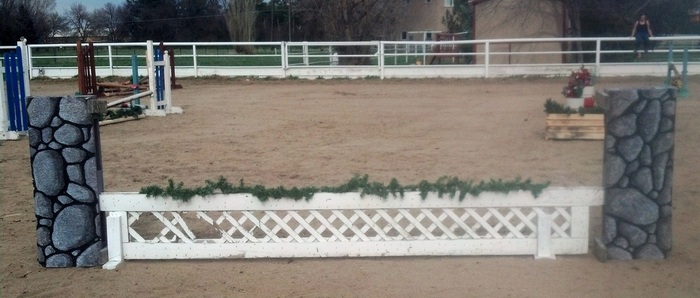
Using pallet walls as wings.
